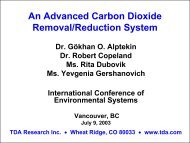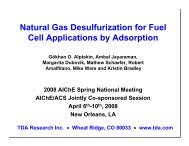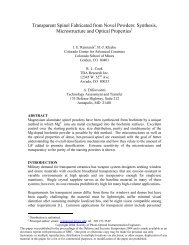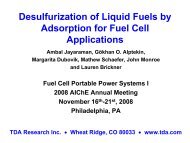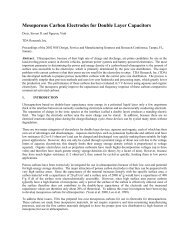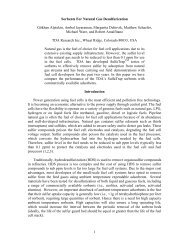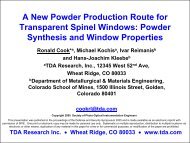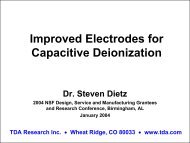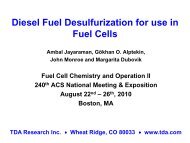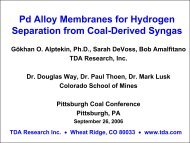Non-Carbon Sorbents for Mercury Removal from Flue Gases
Non-Carbon Sorbents for Mercury Removal from Flue Gases
Non-Carbon Sorbents for Mercury Removal from Flue Gases
You also want an ePaper? Increase the reach of your titles
YUMPU automatically turns print PDFs into web optimized ePapers that Google loves.
<strong>Non</strong>-<strong>Carbon</strong> <strong>Sorbents</strong> <strong>for</strong> <strong>Mercury</strong><strong>Removal</strong> <strong>from</strong> <strong>Flue</strong> <strong>Gases</strong>Gökhan O. Alptekin, Ph.D., MikeCesario, Margarita DubovikPittsburgh Coal ConferencePittsburgh, PASeptember 26, 2006TDA Research Inc. • Wheat Ridge, CO 80033 • www.tda.com
TDA Research, Inc.• Privately Owned / Began operations in 1987• 67 full-time technical staff• Primarily chemists and engineers 60% with advanced degreesWheat Ridge Facility12345-12355 W 52 nd Avenue22,000 ft 2 offices and labsSynthetic Chemistry, Catalyst/SorbentSynthesis and Testing, Machine andElectronics Shops, SEM, TOF Mass SpecGolden Facility4663 Table Mountain Drive27,000 ft 2 offices and labs27 fume hoods, Synthetic Chemistry,Catalytic Process DevelopmentTDAR e s e a r c h
TDA ProductsC60 (Ih)The first commercial (1.3 ton/day)installation of TDA’s partial oxidationtechnology (SulfaTreat DO) atBakersfield, CA .TDA built and licensed all of the reactors<strong>for</strong> the Frontier <strong>Carbon</strong> Corp. 40 ton/yearfullerene factory in Kitakyushu, JapanConducting polymers availablethrough Sigma-AldrichTDAR e s e a r c h
Introduction• <strong>Mercury</strong> emissions <strong>from</strong> wasteincinerators and coal-fired utilities areunder scrutiny• <strong>Mercury</strong> is designated as a “hazardous airpollutant” in the Clean Air Act Amendmentof 1990 because of its harmful effects onhumans and wildlife• Hg is associated with serious neurologicaland developmental effects• A plausible link has been shownbetween the bioaccumulation of methylmercury in fish and the emissions <strong>from</strong>man-made sources• EPA already regulates Hg emissions <strong>from</strong> waste incinerators• More than 40 ton Hg is captured per yearSugar• Clear Sky Initiative requires control of Hg emissions <strong>from</strong>coal-fired plants• 45% reduction by 2010Salt• 70% reduction by 2018TDAR e s e a r c h
Cost of <strong>Mercury</strong> <strong>Removal</strong>• A preferred option of removing mercury is dry sorbent injectionbecause of its low capital cost and it is easy to retrofit• Projected costs with existing abatement technologies usingactivated carbon sorbents can be as high as $55,000 per poundof mercury removed (based on combined operating andannualized capital costs)• $4 million per year <strong>for</strong> a 250 MW power plant (Sjostrom 1997)• The cost of mercury removal at 90% removal efficiency could costto Nation <strong>from</strong> $2 to $6 billion per year• In fact, all these estimates understate the costs• The state-of-the-art carbon sorbents degrade the quality of fly ashwhich is sold as a cement substitute• Fly ash that contains carbon is not suitable <strong>for</strong> use in cement– Based on 3000:1 injection ratio, the carbon content of the flyash can exceed 6%• If the fly ash is not salable <strong>for</strong> concrete, it has no use at all, andimmediately becomes an expensive waste problemTDAR e s e a r c h
Conventional TechnologiesPhysical adsorbents• Low adsorption capacity and mass transfer limitations– Activated carbons– non-specific adsorbents– weak affinity to Hg at flue gas temperatures– Chemically modified carbons– promoters include sulfur, iodine, chlorine (Korpiel, 1997)– better capacity but higher cost (impregnated carbons cost~$1/lb, 2 times higher than $0.50/lb untreated carbon)<strong>Mercury</strong> oxidation and scrubbing(by wet FGD)• Oxidized <strong>for</strong>ms of mercury arereactive and easier to remove, butoxidizing mercury is difficultMass FractionEquilibrium CalculationsHgCl 2Hg 0HgO0 300 600 900 1200Temperature, °CSenior, Boole, Morency, et. al., PSI Final Report, 1997TDAR e s e a r c h
Difficulties in Hg OxidationOxidizingCatalystsWet ScrubberSCRCoalOxidizingChemicalsRef: Srivastava, 2005Residue• Difficulties in Hg oxidation• Lower oxides of mercury are instable• Strong oxidizers are only present in low concentrations in the fluegas (e.g., Cl 2, HCl and NO 2)• Addition of oxidizers is a possibility, but the control of their emissionswill be problematic• It is also economically infeasible to install wet scrubbers solely <strong>for</strong>mercury control (only 20% of the coal-based power plants use wetscrubbers <strong>for</strong> FGD, Hargrove, 1997)TDAR e s e a r c h
TDA’s Approach• TDA Research, Inc. is developing a dry injection sorbent <strong>for</strong>mercury removal <strong>from</strong> flue gases• Features of the sorbent• High capacity and good utilization• Low cost• Achieve greater than 90% mercury removal efficiency• Tolerance to possible flue gas contaminants (e.g., residual SO 2 ,NO x )• Easy disposal• Stabilize mercury permanently (no leaching of mercury)• Does not alter properties of the fly ashTDAR e s e a r c h
Apparatus and Test ConditionsTypical Gas Composition(wet basis)Component Vol%CO 2 10.0%H 2 O 8.0%N 2 79.0%O 2 2.0%SO 2 10-300 ppmNOx 10-50 ppmHg Inlet= 0.01-0.2 mg/m 3Temperature = 100-320 o CPressure= 1-2 psigGHSV= 10,000 – 2,000,000 h -1• 80-150 µm sorbent particles are used in a fixed-bed reactor• All system components are Pyrex or Teflon to minimize mercury amalgamation• <strong>Mercury</strong> is introduced using permeation tubes• Tested samples are sent to an independent lab <strong>for</strong> chemical analysis (ICP-AA) toconfirm measured Hg absorption capacityTDAR e s e a r c h
Schematic of the Test SystemTDAR e s e a r c h
Typical Test Profile0.12T= 140 o C, Hg Inlet Conc.= 0.12 mg/m 3 , GHSV= 180,000 h -1Hg Absorbed Hg = 0.172 = mg, (0.108 wt% wt% loading) loading) - (1085- (1085 micro g micro Hg / g Sorbent) g Hg / g Sorbent)FeedAnalysisFeedAnalysis0.09BreakthroughHg Concentration, mg/m 30.060.030.000 500 1000 1500 2000 2500Run Time (min)• Feed analysis through [O2] a reactor Absorption Started by-pass Absorbtion is Over: per<strong>for</strong>med Start of Regeneration in most mg/m3 cases Hg at thebeginning, in the middle and at the end of each test to ensure stable Hg inletconcentrationTDAR e s e a r c h
Sorbent Per<strong>for</strong>mance at High Temperature40Hg Inlet= 80 µg/m 3 , Simulated <strong>Flue</strong> Gas, GHSV= 120,000 h -13530----- 618-90A, T= 245 o C, GHSV= 120,000 h -1 , Hg Inlet= 80 ug/m 3 , Capacity @ breakthrough = 341 ug/g----- 618-90A, T= 165 o C, GHSV= 120,000 h -1 , Hg Inlet= 80 ug/m 3 , Capacity @ breakthrough = 2,833 ug/gHg Concentration (µg/m 3 )252015105T=245 o CT=165 o C00 1000 2000 3000 4000 5000 6000 7000 8000 9000Run Time (min)• We observed a high Hg capacity at 165 o C (0.29% wt.)• Hg capacity decreases at higher temperatures (at 245 o C, thesorbent achieved 0.034% wt.)TDAR e s e a r c h
Effect of Hg Inlet ConcentrationT= 245 o C, Hg Inlet= 20-80 µg/m 3 , Simulated <strong>Flue</strong> Gas, GHSV= 120,000 h -1403530----- 618-90A, T= 245 o C, GHSV= 120,000 h -1 , Hg Inlet= 80 ug/m 3 , Capacity @ breakthrough = 341 ug/g----- 618-90A, T= 245 o C, GHSV= 120,000 h -1 , Hg Inlet= 20 ug/m 3 , Capacity @ breakthrough = 152 ug/gHg Concentration (µg/m 3 )252015105Hg Inlet= 80µg/m 3 Hg Inlet= 20µg/m 300 600 1200 1800 2400 3000Run Time (min)• We observed a higher Hg capacity at higher Hg inlet• The sorbent achieved 341 µg/g and 152 µg/g at 80 and 20 µg/m 3 Hg inletconcentrationsTDAR e s e a r c h
Per<strong>for</strong>mance Comparison with AC <strong>Sorbents</strong>Hg absorption capacity of AC sorbentsTest Site In<strong>for</strong>mation<strong>Mercury</strong> Capture, %Test SiteCoalParticulateControlACI TestResultsTest DurationPG&EBrayton Point,Unit 1Low-sulfur bituminous,Hg = 0.03 ppm,Cl = 2000-4000 ppmTwo ESPsin series94.5ACI <strong>for</strong> two 5-dayperiods; 10 lb/mmacfPG&ESalem Harbor,Unit 1Low-sulfur bituminous,Hg = 0.03-0.08 ppm,Cl = 206 ppmESP90ACI <strong>for</strong> one 4-dayperiod; 10 lb/mmacfWisconsinElectricPleasantPrairie, Unit 2Subbituminous,Hg = 0.11 ppm,Cl = 8 ppmESP66ACI <strong>for</strong> one 5-dayperiod; 11.3 lb/mmacfAlabamaPowerGaston, Unit 3Low-sulfur bituminous,Hg = 0.14 ppm,Cl =169 ppmESP +smallFFSource: Srivastava, 200590.6 (78)ACI <strong>for</strong> one 9-dayperiod; 1.5 lb/mmacf• AC sorbents requirements range <strong>from</strong> 1.5 to 11.3lb/MMacf• Bench-scale tests shows that TDA’s sorbent is capable of:• 0.3 lb/MMacf at T=165 o C• 4.1 lb/MMacf at T=245 o CTDAR e s e a r c h
Economic Feasibility• The major cost item in dry sorbent injection systems is the costof the sorbent• TDA estimates the cost of its sorbent cost around $1-2/lb• Although it costs more than AC ($0.5/lb) and is somewhat moreexpensive impregnated ACs (e.g. $1/lb Br-AC), TDA’s sorbent hashigher capacity than conventional sorbents especially at elevatedtemperatures• Key benefit is lower sorbent usage and the absence of carboncontamination of fly ash• As a result our sorbent has minimal impact on the propertiesof fly ash• Based on the fixed-bed test results, sorbent replacement cost canbe lowered to $1,000-$2,000/lb Hg• Even with the annualized cost of capital <strong>for</strong> the injection systemand cost of parasitic losses, it is possible to greatly reduce cost ofmercury removalTDAR e s e a r c h
Future Work• Once the screening is completed, the operating conditions will beoptimized• The impact of impurities in the flue gases needs to be determined• HCl and SO 3are of particular interest• The fate and stability of the mercury adsorbed on the sorbent has to bedetermined• Leachability studies• The impact of the non-carbon sorbent on fly ash properties needs to beassessed• The impact of the Hg system on the plant efficiency, operational flexibilityneeds to be assessed• The sorbent per<strong>for</strong>mance needs to be demonstrated at large-scale in arepresentative test• All data to date are limited to fixed-bed bench-scale testing, while thesorbent per<strong>for</strong>mance should be measured in injection mode• In collaboration with Apogee Scientific, Inc. the sorbent per<strong>for</strong>mance willbe demonstrated in the injection mode at Excel Energy’s Pawnee PowerPlantTDAR e s e a r c h
Acknowledgments• The funding <strong>for</strong> this work is provided by anEPA SBIR Phase II Grant (Contract No. EP-D-06-043) and DOE SBIR Phase I GrantTDAR e s e a r c h



